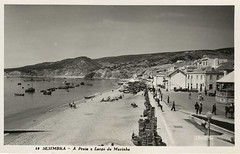Marinha Square
 Marinha Sq. [Navy Sq.] was also known as "Square of the Valiants", because, as the legend says, it was the place where bold and angry fishermen confronted each other. Until 1972, the selling of the fish was made by auction in the beach in front. In those days, the place was full of life: fishing boats stayed close to the beach, and small boats made the transfer of the fish, that was placed on the sand in special rows, different for each species. Then, the buyers made a circle around the fish and a man began "singing" a countdown of price, until a buyer shouted "chui!", meaning he was buying at that exact price. At the square, a number of trucks received the fish transported with the help of donkeys, and then, took it outside town. A crowd was allways watching the fantastic movements of the crowd, on the beach below. Marinha Sq. [Navy Sq.] was also known as "Square of the Valiants", because, as the legend says, it was the place where bold and angry fishermen confronted each other. Until 1972, the selling of the fish was made by auction in the beach in front. In those days, the place was full of life: fishing boats stayed close to the beach, and small boats made the transfer of the fish, that was placed on the sand in special rows, different for each species. Then, the buyers made a circle around the fish and a man began "singing" a countdown of price, until a buyer shouted "chui!", meaning he was buying at that exact price. At the square, a number of trucks received the fish transported with the help of donkeys, and then, took it outside town. A crowd was allways watching the fantastic movements of the crowd, on the beach below.
There is still a 'bait and hook store' dating from those days, the "Casa Naval", better known by the nickname Palhinhas ("small straws"), selling articles for fisheries — you should take a look.
Nowadays this is a quiet square, with a fantastic view of the Sea, and a number of good restaurants: 'Farol', 'Rodízio', 'Filipe', 'Pescador', 'Tasca do Maritimo'. There is also the bar 'Corsario', once a tavern (photo) explored also by mr. Isaias, the same person refered below; at 'Corsario', you can drink the traditional licor 'Pescador' (pression).
Taking Capitao Leitao St. (close to restaurant Farol) you'll get to Galé, a modest coffee/snack with a superb balcony view of the Sea. |




2 Comentários:
Cafe Fontinha
Hello - I just wanted to say I love your blog and read it everyday. I am based in London.
My mother is from Sesimbra she worked in the Cafe Fontinha - her name is Liliana. She remembers you and your sister, and recognizes you from the page of the Sesimbra blogger. She sends her compliments.
Liliana (filha)
Thank you. Maybe your mother is refering to my cousins João Pedro Aldeia, that used also to go to the café Fontinha, and her sister Olinda. I am João Augusto Aldeia, also a great fan of Fontinha coffee and its jukebox.
Enviar um comentário
Subscrever Enviar feedback [Atom]
<< Página inicial